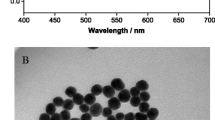Abstract
DNA microarrays are promising tools for fast and highly parallel DNA detection by means of fluorescence or gold nanoparticle labeling. However, substrate modification with silanes (as a prerequisite for capture DNA binding) often leads to inhomogeneous surfaces and/or nonspecific binding of the labeled DNA. We examined both different substrate cleaning and activating protocols and also different blocking strategies for optimizing the procedures, especially those for nanoparticle labeling. Contact angle measurements as well as fluorescence microscopy, atomic force microscopy (AFM), and a flatbed scanner were used to analyze the multiple-step process. Although the examined different cleaning and activating protocols resulted in considerably different contact angles, meaning different substrate wettability, silanization led to similar hydrophobic surfaces which could be revealed as smooth surfaces of about 2–4 nm roughness. The two examined silanes (3-glycidoxypropyltrimethoxysilane (GOPS) and 3-aminopropyltriethoxysilane (APTES)) differed in their DNA binding homogeneity, maximum signal intensities, and sensitivity. Nonspecific gold binding on APTES/PDC surfaces could be blocked by treatment in 3% bovine serum albumin (BSA).
Similar content being viewed by others
References
M. Schena, R. A. Heller, T. P. Theriault, K. Konrad, E. Lachenmeier, and R. W. Davis (1998). Microarrays: Biotechnology’s discovery platform for functional genomics. Trends Biotechnol. 16, 301–306.
C. M. Niemeyer and D. Blohm (1999). DNA Microarrays. Angew Chem. 111, 3039–3043.
C. A. Mirkin, R. L. Letsinger, R. C. Mucic, and J. J. Storhoff (1996). A DNA-based method for rationally assembling nanoparticles into macroscopic materials. Nature 382, 607–609.
A. P. Alivisatos, K. P. Johnsson, X. Peng, T. E. Wilson, C. J. Loweth, M. P. Bruchez Jr., and P. G. Schultz (1996). Organization of ‘nanocrystal molecules’ using DNA. Nature 382, 609–611.
J. Reichert, A. Csaki, J. M. Köhler, and W. Fritzsche (2000). Chip-based optical detection of DNA hybridization by means of Nanobead Labeling. Anal. Chem. 72, 6025–6029.
T. A. Taton, C. A. Mirkin, and R. L. Letsinger (2000). Scanometric DNA array detection with nanoparticle probes. Science 289, 1757–1760.
R. Möller, A. Csaki, J. M. Köhler, and W. Fritzsche (2001). Electrical classification of the concentration of bioconjugated metal colloids after surface adsorption and silver enhancement. Langmuir 17, 5426–5430.
S. J. Park, T. A. Taton, and C. A. Mirkin (2002). Array-based electrical detection of DNA with nanoparticle probes. Science 295, 1503–1506.
G.-J. Zhang, R. Möller, A. Csaki, and W. Fritzsche (2002). in W. Fritzsche (Ed.), AIP Conference Proceedings on DNA Based Molecular Construction. Jena, Germany, Vol. 640, pp. 13–21.
N. Zammatteo, L. Jeanmart, S. Hamels, S. Courtois, P. Louette, L. Hevesi, and J. Remacle (2000). Comparison between different strategies of covalent attachment of DNA to glass surfaces to build DNA microarrays. Anal. Biochem. 280, 143–150.
J. J. Storhoff, R. Elghanian, R. C. Mucic, C. A. Mirkin, and R. L. Letsinger. (1998). One pot colorimetric differentiation of polynucleotides with single base imperfections using gold nanoparticle probes. J. Am. Chem. Soc. 120, 1959–1964.
A. Csaki, R. Möller, W. Straube, J. M. Köhler, and W. Fritzsche (2001). DNA monolayer on gold substrates characterized by nanoparticle labeling and scanning force microscopy. Nucleic Acids Res. 29, e81.
H. Cai, Y. Wang, P. He, and Y. Fang (2002). Electrochemical detection of DNA hybridization based on silver-enhanced gold nanoparticle label. Anal. Chim. Acta 469, 165–172.
J. B. Lamture, K. L. Beattie, B. E. Burke, M. D. Eggers, D. J. Ehrlich, R. Fowler, M. A. Hollis, B. B. Kosicki, R. K. Reich, S. R. Smith, R. S. Varma, and M. E. Hogan (1994). Direct detection of nucleic acid hybridization on the surface of a charge coupled device. Nucleic Acids Res. 22, 2121–2125.
Z. Guo, R. A. Guilfoyle, A. J. Thiel, R. Wang, and L. M. Smith (1994). Direct fluorescence analysis of genetic polymorphisms by hybridization with oligonucleotide arrays on glass supports. Nucleic Acids Res. 22, 5456–5465.
R. Wirtz, C. Wälti, W. A. Germishuizen, M. Pepper, A. P. J. Middelberg, and A. G. Davies (2003). High-sensitivity colorimetric detection of DNA hybridzation on a gold surface with high spatial resolution. Nanotechnology 14, 7–10.
G. W. Hacker, G. Danscher, G. Bernatzky, W. Muss, H. Adam, and J. Thurner (1988). Silver acetate autometallography: An alternative enhancement technique for immunogold-silver staining (IGSS) and silver amplification of gold, silver, mercury and zinc in tissues. J. Histotechnol. 11, 213–221.
W. Fritzsche, A. Csaki, and R. Möller (2002). Nanoparticle-based optical detection of molecular interactions for DNA-chip technology. SPIE 4626, 17–22.
F. Diehl, S. Grahlmann, M. Beier, and J. D. Hoheisel (2001). Manufacturing DNA microarrays of high spot homogeneity and reduced background signal. Nucleic Acids Res. 29, e38.
Y. H. Yang, M. J. Buckley, and T. P. Speed (2001). Analysis of cDNA microarray images. Brief Bioinform. 2, 341–349.
C. Kooperberg, T. G. Fazzio, J. J. Delrow, and T. Tsukiyama (2002). Improved background correction for spotted DNA microarrays. J. Comput. Biol. 9, 55–66.
T. L. Fare, E. M. Coffey, H. Dai, Y. D. He, D. A. Kessler, K. A. Kilian, J. E. Koch, E. LeProust, M. J. Marton, M. R. Meyer, et al. (2003). Effects of atmospheric ozone on microarray data quality. Anal. Chem. 75, 4672–7675.
S. Taylor, S. Smith, B. Windle, and A. Guiseppi-Elie (2003). Impact of surface chemistry and blocking strategies on DNA microarrays. Nucleic Acids Res. 31, e87.
J. J. Cras, C. A. Rowe-Taitt, D. A. Nivens, and F. S. Ligler (1999). Comparison of chemical cleaning methods of glass in preparation for silanization. Biosens. Bioelectr. 14, 683–688.
J. Li, H. Wang, Y. Zhao, L. Chen, N. He, and Z. Lu (2001). Assembly method fabricating linkers for covalently bonding DNA on glass surface. Sensors 1, 53–59.
G. Jogikalmath (2002) in H. Group (Ed.). Available from http://afm1.pharm.utah.edu/BELCourse/BELSurfSilanPattern.html.
P. L. Dolan, Y. Wu, L. K. Ista, R. L. Metzenberg, M. A. Nelson, and G. P. Lopez (2001). Robust and efficient synthetic method for forming DNA microarrays. Nucleic Acids Res. 29, e107.
Author information
Authors and Affiliations
Corresponding author
Rights and permissions
About this article
Cite this article
Festag, G., Steinbrück, A., Wolff, A. et al. Optimization of Gold Nanoparticle-Based DNA Detection for Microarrays. J Fluoresc 15, 161–170 (2005). https://doi.org/10.1007/s10895-005-2524-4
Received:
Accepted:
Issue Date:
DOI: https://doi.org/10.1007/s10895-005-2524-4




